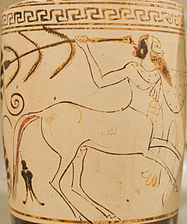Centaur
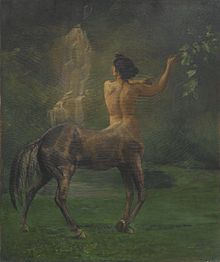 Centauress,by John La Farge | |
| Grouping | Legendary creature |
|---|---|
| Sub grouping | Hybrid |
| Similar entities | Minotaur,satyr,harpy |
| Folklore | Greek |
| Other name(s) | Kentaur, Centaurus, Sagittary[1] |
| Region | Greece,Cyprus |
| Habitat | Land |
Acentaur(/ˈsɛntɔːr,ˈsɛntɑːr/SEN-tor,SEN-tar;Ancient Greek:κένταυρος,romanized:kéntauros;Latin:centaurus), occasionallyhippocentaur,also calledIxionidae(Ancient Greek:Ἰξιονίδαι,romanized:Ixionídai,lit. 'sons ofIxion'), is a creature fromGreek mythologywith the upper body of a human and the lower body and legs of ahorsethat was said to live in the mountains ofThessaly.[2]In one version of the myth, the centaurs were named afterCentaurus,and, through his brotherLapithes,were kin to the legendary tribe of theLapiths.
Centaurs are thought of in many Greek myths as being as wild as untamed horses, and were said to have inhabited the region ofMagnesiaand MountPelionin Thessaly, theFoloi oak forestinElis,and the Malean peninsula in southernLaconia.Centaurs are subsequently featured inRoman mythology,and were familiar figures in the medieval bestiary. They remain a staple of modern fantastic literature.
Etymology
[edit]The Greek wordkentaurosis generally regarded as being of obscure origin.[3]Theetymologyfromken+tauros,'piercing bull', was aeuhemeristsuggestion inPalaephatus' rationalizing text on Greek mythology,On Incredible Tales(Περὶ ἀπίστων), which included mounted archers from a village calledNepheleeliminating a herd of bulls that were the scourge of Ixion's kingdom.[4]Another possible related etymology can be "bull-slayer".[5]
Mythology
[edit]
Creation of centaurs
[edit]The centaurs were usually said to have been born ofIxionandNephele.[6]As the story goes, Nephele was a cloud made into the likeness ofHerain a plot to trick Ixion into revealing his lust for Hera toZeus.Ixion seduced Nephele and from that relationship centaurs were created.[7]Another version, however, makes them children ofCentaurus,a man who mated with theMagnesianmares. Centaurus was either himself the son of Ixion and Nephele (inserting an additional generation) or ofApolloand the nymphStilbe.In the latter version of the story, Centaurus's twin brother wasLapithes,ancestor of theLapiths.
Another tribe of centaurs was said to have lived onCyprus.According toNonnus,theCyprian Centaurswere fathered byZeus,who, in frustration afterAphroditehad eluded him, spilled his seed on the ground of that land. Unlike those of mainland Greece, the Cyprian centaurs were ox-horned.[8][9]
There were also theLamian Pheres,twelve rusticdaimones(spirits) of theLamos river.They were set byZeusto guard the infantDionysos,protecting him from the machinations ofHera,but the enraged goddess transformed them into ox-horned Centaurs unrelated to the Cyprian Centaurs. The Lamian Pheres later accompanied Dionysos in his campaign against the Indians.[10]
The centaur's half-human, half-horse composition has led many writers to treat them asliminal beings,caught between the two natures they embody in contrasting myths; they are both the embodiment of untamed nature, as in their battle with the Lapiths (their kin), and conversely, teachers likeChiron.[11]
Centauromachy
[edit]The Centaurs are best known for their fight with theLapithswho, according to one origin myth, would have been cousins to the centaurs. The battle, called the Centauromachy, was caused by the centaurs' attempt to carry offHippodamiaand the rest of the Lapith women on the day of Hippodamia's marriage toPirithous,who was the king of the Lapithae and a son of Ixion.Theseus,a hero and founder of cities, who happened to be present, threw the balance in favour of the Lapiths by assisting Pirithous in the battle. The Centaurs were driven off or destroyed.[12][13][14]Another Lapith hero,Caeneus,who was invulnerable to weapons, was beaten into the earth by Centaurs wielding rocks and the branches of trees. In her article "The Centaur: Its History and Meaning in Human Culture", Elizabeth Lawrence claims that the contests between the centaurs and the Lapiths typify the struggle between civilization and barbarism.[15]
The Centauromachy is most famously portrayed in themetopes of the ParthenonbyPhidiasand in theBattle of the Centaurs,a relief byMichelangelo.
List of centaurs
[edit]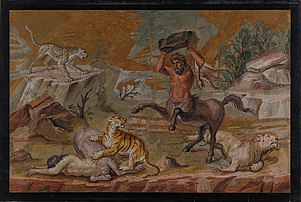
- Abas,attended Pirithous' wedding, fought against the Lapiths and fled.[16]
- Agrius,repelled by Heracles in a fight.[17]
- Amphion,tried to plunder Pholus of his wine and was killed by Heracles.[18]
- Amycus,son ofOphion.He attended Pirithous' wedding and fought against the Lapiths. Amycus was killed byPelates.[19]
- Anchius,repelled by Heracles when he tried to steal the wine of Pholus.[17]
- Antimachus,attended Pirithous' wedding, fought in the battle against the Lapiths and was killed by Caeneus.[20]
- Aphareus,killed by Theseus in the fight at Pirithous' wedding.[21]
- Aphidas,killed byPhorbasin the fight at Pirithous' wedding.[22]
- Arctus,attended Pirithous' wedding and fought against the Lapiths.[23]
- Areos,attended Pirithous' wedding and fought against the Lapiths.[24]
- Argius,killed by Heracles when he tried to steal the wine of Pholus.[18]
- Asbolus,an augur who had attempted in vain to dissuade his friends from engaging in battle against the Lapiths at Pirithous' wedding.[25]
- Bienor,attended Pirithous' wedding, fought in the battle against the Lapiths and was killed by Theseus.[26]
- Bromus,attended Pirithous' wedding, fought in the battle against the Lapiths and was killed by Caeneus.[27]
- Chiron,the son ofCronusandPhilyra.
- Chromis,attended Pirithous' wedding, fought in the battle against the Lapiths and was killed by Pirithous.[28]
- Chthonius,attended Pirithous' wedding, fought in the battle against the Lapiths and was killed by Nestor.[29]
- Clanis,attended Pirithous' wedding, fought in the battle against the Lapiths and was killed by Peleus.[30]
- Crenaeus,attended Pirithous' wedding, fought in the battle against the Lapiths and was killed by Dryas.[24]
- Cyllarus,attended Pirithous' wedding, fought in the battle against the Lapiths. Killed by a javelin thrown from an unknown hand. He was married to Hylonome.[31]
- Daphnis,tried to plunder Pholus of his wine and was killed by Heracles.[18]
- Demoleon,attended Pirithous' wedding, fought in the battle against the Lapiths and was killed by Peleus.[32]
- Dictys,attended Pirithous' wedding, fought in the battle against the Lapiths and was killed by Pirithous.[33]
- Dorylas,attended Pirithous' wedding, fought in the battle against the Lapiths and was killed by Peleus.[34]
- Doupon,tried to plunder Pholus of his wine and was killed by Heracles.[18]
- Dryalus,son of Peuceus who attended Pirithous' wedding and fought against the Lapiths.[19]
- Echeclus,attended Pirithous' wedding, fought in the battle against the Lapiths and was killed by Ampyx.[35]
- Elatus,tried to plunder Pholus of his wine. Heracles shot an arrow at him, which, passing through his arm, stuck in the knee of Chiron.[17]
- Elymus,attended Pirithous' wedding, fought in the battle against the Lapiths and was killed by Caeneus.[27]
- Eurynomus,fought against the Lapiths at Pirithous' wedding. Killed by Dryas.[24]
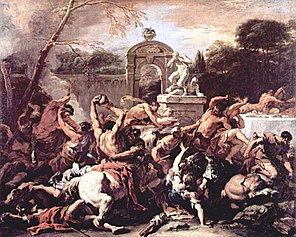
Painting bySebastiano Ricci,of centaurs at the marriage ofPirithous,king of theLapithae - Eurytion,acted in an insulting manner towards Hippolyte when she was being joined in marriage to Azan in the house of Pirithous. He was killed by Heracles.[36]
- Eurytus,the wildest of the wild Centaurs. He started the fight at Pirithous' wedding and was killed by Theseus.[37]
- Gryneus,fought against the Lapiths at Pirithous' wedding and was killed byExadius.[38]
- Helops,attended Pirithous' wedding and fought in the battle against the Lapiths. While fleeing from Pirithous, he fell from a precipice into the top of a tree and impaled his body.[33]
- Hippasus,fought against the Lapiths at Pirithous' wedding. Killed by Theseus.[39]
- Hippotion,another Centaur, killed by Heracles when he tried to steal the wine of Pholus.[18]
- Hodites,fought against the Lapiths at Pirithous' wedding. Killed by Mopsus.[40]
- Homadus,tried to plunder Pholus of his wine. Some time after he attempted to rape Alcyone, a granddaughter of Perseus. He got killed in Arcadia.[18]
- Hylaeus,tried to rape Atalanta but was shot by her (same thing happened to Rhoecus).[41][42]
- Hylaeus, killed by Heracles under unknown circumstances.[43]
- Hylaeus, followed Dionysus in his Indian campaign and was killed by Orontes, an Indian General.[44]
- Hyles,attended Pirithous' wedding, fought in the battle against the Lapiths and was killed by Peleus.[34]
- Hylonome,attended Pirithous' wedding together with her lover Cyllarus. Having seen the latter dead, she threw herself upon the spear which had killed him.[45]
- Imbreus,fought against the Lapiths at Pirithous' wedding and was killed by Dryas.[24]
- Iphinous,fought against the Lapiths at Pirithous' wedding and was killed by Peleus.[34]
- Isoples,killed by Heracles when he tried to steal the wine of Pholus.[18]
- Latreus,fought against the Lapiths at Pirithous' wedding and was killed by Caeneus.[46]
- Lycabas,attended Pirithous' wedding, fought against the Lapiths and fled.[47]
- Lycidas,fought against the Lapiths at Pirithous' wedding and was killed by Dryas.[24]
- Lycopes,fought against the Lapiths at Pirithous' wedding and was killed by Theseus.[48]
- Lycus,fought against the Lapiths at Pirithous' wedding was killed by Pirithous.[49]
- Medon,attended Pirithous' wedding, fought against the Lapiths and fled.[47]
- Melanchaetes,killed by Heracles when he tried to steal the wine of Pholus.[18]
- Melaneus,attended Pirithous' wedding, fought against the Lapiths and fled.[16]
- Mermerus,wounded by the Lapiths at Pirithous' wedding and fled.[50]
- Mimas,attended Pirithous' wedding and fought against the Lapiths.[19]
- Monychus,attended Pirithous' wedding and fought in the battle against the Lapiths. He was conquered by Nestor, mounted on his unwilling back.[51]
- Nedymnus,fought against the Lapiths at Pirithous' wedding. Killed by Theseus.[48]
- Nessus,fled during the fight with the Lapiths at Pirithous' wedding. Later he attempted to rape Deianira and before dying gave her a charm which resulted in the death of Heracles. He was killed by the latter.[52]
- Ophion,father of Amycus.[19]
- Oreius,killed by Heracles when he tried to steal the wine of Pholus.[53]
- Orneus,attended Pirithous' wedding fought against the Lapiths and fled.[54]
- Perimedes,son of Peuceus and attended Pirithous' wedding and fought against the Lapiths.[19]
- Petraeus,fought against the Lapiths at Pirithous' wedding and was killed by Pirithous.[55]
- Peuceus,father of Perimedes and Dryalus.[19]
- Phaecomes,fought against the Lapiths at Pirithous' wedding and was killed by Nestor.[56]
- Phlegraeus,fought against the Lapiths at Pirithous' wedding and was killed by Peleus.[34]
- Pholus
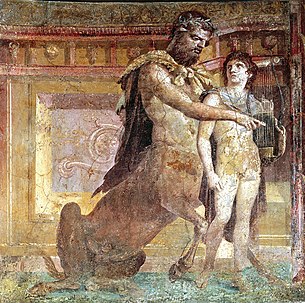
ChironteachingAchilleshow to play thelyre,a Roman fresco fromHerculaneum,1st century AD. - Phrixus,killed by Heracles when he tried to steal the wine of Pholus.[18]
- Pisenor,attended Pirithous' wedding, fought against the Lapiths and fled.[57]
- Pylenor,having been wounded by Heracles washed himself in the river Anigrus, thus providing the river with a peculiar odor.[58]
- Pyracmus,fought against the Lapiths at Pirithous' wedding and was killed by Caeneus.[27]
- Pyraethus,fought against the Lapiths at Pirithous' wedding and was killed by Periphas.[35]
- Rhoecus,He also tried to rape Atalanta and was killed by her.[41]
- Rhoetus,fought against the Lapiths at Pirithous' wedding and was killed by Dryas.[59]
- Ripheus,fought against the Lapiths at Pirithous' wedding and was killed by Theseus.[60]
- Styphelus,fought against the Lapiths at Pirithous' wedding and was killed by Caeneus.[27]
- Teleboas,fought against the Lapiths at Pirithous' wedding and was killed by Nestor.[29]
- Thaumas,attended Pirithous' wedding, fought against the Lapiths and fled.[57]
- Thereus,this Centaur used to catch bears and carry them home alive and struggling. Attended Pirithous' wedding and fought in the battle against the Lapiths. Killed by Theseus.[61]
- Thereus, killed by Heracles when he tried to steal the wine of Pholus.[62]
- Ureus,attended Pirithous' wedding and fought against the Lapiths.[63]
Origin of the myth
[edit]The most common theory holds that the idea of centaurs came from the first reaction of a non-riding culture, as in theMinoanAegean world,to nomads who were mounted on horses. The theory suggests that such riders would appear as half-man, half-animal.Bernal Díaz del Castilloreported that theAztecsalso had this misapprehension about Spanish cavalrymen.[64]The Lapith tribe of Thessaly, who were the kinsmen of the Centaurs in myth, were described as the inventors of horse-riding by Greek writers. The Thessalian tribes also claimed their horse breeds were descended from the centaurs.
Robert Graves(relying on the work ofGeorges Dumézil,[65]who argued for tracing the centaurs back to theIndianGandharva), speculated that the centaurs were a dimly remembered, pre-Hellenic fraternal earth cult who had the horse as atotem.[66]A similar theory was incorporated intoMary Renault'sThe Bull from the Sea.
Variations
[edit]Female centaurs
[edit]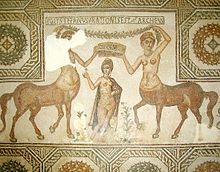
Though female centaurs, calledcentauridesor centauresses, are not mentioned in early Greek literature and art, they do appear occasionally in later antiquity. AMacedonianmosaic of the 4th century BC is one of the earliest examples of the centauress in art.[67]Ovidalso mentions a centauress namedHylonome[i]who committed suicide when her husbandCyllaruswas killed in the war with the Lapiths.[68]

India
[edit]The Kalibangancylinder seal,dated to be around 2600–1900 BC,[69]found at the site ofIndus-Valley civilizationshows a battle between men in the presence of centaur-like creatures.[70][69]Other sources claim the creatures represented are actually half human and half tigers, later evolving into theHinduGoddess of War.[71][72]These seals are also evidence ofIndus-Mesopotamia relationsin the 3rd millennium BC.
In a popular legend associated withPazhaya Sreekanteswaram TempleinThiruvananthapuram,the curse of a saintlyBrahmintransformed a handsomeYadavaprince into a creature having a horse's body and the prince's head, arms, and torso in place of the head and neck of the horse.
Kinnaras,another half-man, half-horse mythical creature fromIndian mythology,appeared in various ancient texts, arts, and sculptures from all aroundIndia.It is shown as a horse with the torso of a man where the horse's head would be, and is similar to a Greek centaur.[73][74]
Russia
[edit]A centaur-like half-human, half-equine creature calledPolkanappeared in Russian folk art andlubokprints of the 17th–19th centuries. Polkan is originally based onPulicane,a half-dog fromAndrea da Barberino's poemI Reali di Francia,which was once popular in the Slavonic world in prosaic translations.
Artistic representations
[edit]Classical art
[edit]
The extensive Mycenaean pottery found atUgaritincluded two fragmentary Mycenaean terracotta figures which have been tentatively identified as centaurs. This finding suggests aBronze Ageorigin for these creatures of myth.[75]A painted terracotta centaur was found in the "Hero's tomb" atLefkandi,and by theGeometric period,centaurs figure among the first representational figures painted on Greek pottery. An often-published Geometricperiod bronze of a warrior face-to-face with a centauris at theMetropolitan Museum of Art.[76]
InGreek artof theArchaic period,centaurs are depicted in three different forms.
- Some centaurs are depicted with a human torso attached to the body of a horse at thewithers,where the horse's neck would be; this form, designated "Class A" by Professor Paul Baur, later became standard.
- "Class B" centaurs are depicted with a human body and legs joined at the waist to the hindquarters of a horse; in some cases centaurs of both Class A and Class B appear together.
- A third type, designated "Class C", depicts centaurs with human forelegs terminating in hooves. Baur describes this as an apparent development ofAeolicart, which never became particularly widespread.[77]
There are also paintings and motifs onamphorae[78]and Dipylon cups[79]which depict winged centaurs.
Centaurs were also frequently depicted in Roman art. One example is the pair of centaurs drawing the chariot ofConstantine the Greatand his family in the Great Cameo of Constantine (circaAD 314–16), which embodies wholly pagan imagery, and contrasts sharply with the popular image of Constantine as the patron of early Christianity.[80][81]
Medieval art
[edit]

Centaurs preserved aDionysianconnection in the 12th-centuryRomanesquecarvedcapitalsofMozac Abbeyin theAuvergne.Other similar capitals depict harvesters, boys riding goats (a further Dionysiac theme), andgriffinsguarding thechalicethat held the wine. Centaurs are also shown on a number ofPictishcarved stones from north-eastScotlanderected in the 8th–9th centuries AD (e.g., atMeigle,Perthshire). Though outside the limits of theRoman Empire,these depictions appear to be derived from Classical prototypes.
Modern art
[edit]TheJohn C. Hodges library at The University of Tennesseehosts a permanent exhibit of a "Centaur fromVolos"in its library. The exhibit, made by sculptor Bill Willers by combining a study human skeleton with the skeleton of aShetland pony,is entitled "Do you believe in Centaurs?". According to the exhibitors, it was meant to mislead students in order to make them more critically aware.[82]
Cartography
[edit]Depictions of centaurs in a mythical land located south beyond the world's known continents appear on a map byUrbano Montifrom 1587, sometimes called Monti's Planisphere.[83]
In heraldry
[edit]Centaurs are common in European heraldry, although more frequent in continental than in British arms. A centaur holding a bow is referred to as asagittarius.[84]
Literature
[edit]Classical literature
[edit]
Jerome's version of theLifeof StAnthony the Great,written byAthanasius of Alexandriaabout the hermit monk of Egypt, was widely disseminated in the Middle Ages; it relates Anthony's encounter with a centaur who challenged the saint, but was forced to admit that the old gods had been overthrown. The episode was often depicted inThe Meeting of St Anthony Abbot and St Paul the Hermitby the painterStefano di Giovanni,who was known as "Sassetta".[85]Of the two episodic depictions of thehermit Anthony's travel to greet the hermit Paul, one is his encounter with the demonic figure of a centaur along the pathway in a wood.
Lucretius,in his first-century BC philosophical poemOn the Nature of Things,denied the existence of centaurs, based on the differing rates of growth of human and equine anatomies. Specifically, he states that at the age of three years, horses are in the prime of their life while humans at the same age are still little more than babies, making hybrid animals impossible.[86]
Medieval literature
[edit]Centaurs are among the creatures which 14th-century Italian poetDanteplaced as guardians in hisInferno.In Canto XII, Dante and his guideVirgilmeet a band led byChironandPholus,guarding the bank ofPhlegethonin the seventh circle of Hell, a river of boiling blood in which the violent against their neighbours are immersed, shooting arrows into any who move to a shallower spot than their allotted station. The two poets are treated with courtesy, andNessusguides them to a ford.[87]In Canto XXIV, in the eighth circle, in Bolgia 7, a ditch where thieves are confined, they meet but do not converse withCacus(who is a giant in the ancient sources), wreathed in serpents and with a fire-breathing dragon on his shoulders, arriving to punish a sinner who has just cursed God.[88]In hisPurgatorio,an unseen spirit on the sixth terrace cites the centaurs ( "the drunken double-breasted ones who fought Theseus" ) as examples of the sin ofgluttony.[89]
Modern day literature
[edit]C.S. Lewis'The Chronicles of Narniaseries depicts centaurs as the wisest and noblest of creatures.Narnian Centaursare gifted at stargazing, prophecy, healing, and warfare; a fierce and valiant race always faithful to the High KingAslanthe Lion.
InJ.K. Rowling'sHarry Potterseries, centaurs live in theForbidden Forestclose toHogwarts,preferring to avoid contact with humans. They live in societies called herds and are skilled at archery, healing, and astrology, but like in the original myths, they are known to have some wild and barbarous tendencies.
With the exception ofChiron,the centaurs inRick Riordan'sPercy Jackson & the Olympiansare seen as wild party-goers who use a lot of American slang. Chiron retains his mythological role as a trainer of heroes and is skilled in archery. In Riordan's subsequent series,Heroes of Olympus,another group of centaurs are depicted with more animalistic features (such as horns) and appear as villains, serving theGigantes.
Philip Jose Farmer'sWorld of Tiersseries (1965) includes centaurs, called Half-Horses or Hoi Kentauroi. His creations address several of the metabolic problems of such creatures—how could the human mouth and nose intake sufficient air to sustain both itself and the horse body and, similarly, how could the human ingest sufficient food to sustain both parts.
Brandon Mull'sFablehavenseries features centaurs that live in an area called Grunhold. The centaurs are portrayed as a proud, elitist group of beings that consider themselves superior to all other creatures. The fourth book also has a variation on the species called an Alcetaur, which is part man, part moose.
The myth of the centaur appears inJohn Updike's novelThe Centaur.The author depicts a rural Pennsylvanian town as seen through the optics of the myth of the centaur. An unknown and marginalized local school teacher, just like the mythological Chiron did for Prometheus, gave up his life for the future of his son who had chosen to be an independent artist in New York.
Gallery
[edit]-
Botticelli,Pallasand Centaur(1482–83)
-
Antonio Canova,Theseus Defeats the Centaur(1805–1819)
-
Prince Bova fightsPolkan,Russianlubok(1860)
-
A bronze statue of a centaur, after theFurietti Centaurs
See also
[edit]Other hybrid creatures appear in Greek mythology, always with some liminal connection that links Hellenic culture with archaic or non-Hellenic cultures:
- Furietti Centaurs
- Hippocamp
- Hybrid (mythology)
- Ipotane- Another half-human half-horse creature.
- Legendary creature
- Lists of legendary creatures
- Minotaur
- Onocentaur- A type of centaur that is part-donkey.
- Ichthyocentaur- A type of aquatic centaur with a fish tail instead of hindquarters.
- Sagittarius
- Satyr
Also,
- HinduKamadhenu
- IndianKinnarawhich are half-horse and half-man creatures.
- IslamicBuraq,a heavenly steed often portrayed as an equine being with a human face.
- PhilippineTikbalang
- RomanFaun,and theHippopodesofPomponius Mela,Pliny the Elder,and later authors.
- ScottishEach uisgeandNuckelavee
- WelshCeffyl Dŵr
Additionally,Bucentaur,the name of several historically importantVenetianvessels, was linked to a posited ox-centaur orβουκένταυρος(boukentauros)by fanciful and likely spurious folk-etymology.
Footnotes
[edit]- ^The nameHylonomeis Greek, so Ovid may have drawn her story from an earlier Greek writer.
References
[edit]- ^For Collins English Dictionary: "sagittary." Collins English Dictionary – Complete and Unabridged, 12th Edition 2014. 1991, 1994, 1998, 2000, 2003, 2006, 2007, 2009, 2011, 2014. HarperCollins Publishers September 1, 2019,https:// thefreedictionary /sagittary
- ^"Definition ofcentaurby Merriam-Webster ".merriam-webster.Merriam-Webster Dictionary.RetrievedJune 6,2021.
- ^Scobie, Alex (1978). "The Origins of 'Centaurs'".Folklore.89(2): 142–147.doi:10.1080/0015587X.1978.9716101.Scobie quotesNilsson, Martin P.(1955).Geschichte der griechischen Religion.
Die Etymologie und die Deutung der Ursprungs sind unsicher und mögen auf sich beruhen
- ^Scobie (1978),p. 142.
- ^Alexander Hislop,in his polemicThe Two Babylons:Papal Worship Revealed to be the Worship of Nimrod and His Wife(1853, revised 1858), theorized that the word is derived from theSemiticKohenand "tor" (to go round) viaphonetic shiftthe less prominentconsonantsbeing lost over time, with it developing intoKhenTororKen-Tor,and being transliterated phonetically intoIonianasKentaur,but this is not accepted by any modern philologist.
- ^Nash, Harvey (June 1984). "The Centaur's Origin: A Psychological Perspective".The Classical World.77(5): 273–291.doi:10.2307/4349592.JSTOR4349592.
- ^Alexander, Jonathann."Tzetzes, Chiliades 9".Theoi.Theoi Project.RetrievedFebruary 28,2019.
- ^Nonnus,Dionysiaca5.611 ff., 14.193 ff. & 32.65 ff.
- ^"CYPRIAN CENTAURS (Kentauroi Kyprioi) - Half-Horse Men of Greek Mythology".theoi.
- ^"LAMIAN PHERES - Centaurs of Dionysus in Greek Mythology".theoi.
- ^"Chiron | Greek mythology | Britannica".britannica.RetrievedOctober 27,2022.
- ^Plutarch,Theseus30
- ^Ovid,Metamorphoses12.210
- ^Diodorus Siculusiv.pp. 69-70.
- ^Lawrence, Elizabeth Atwood (1994). "The Centaur: Its History and Meaning in Human Culture".Journal of Popular Culture.27(4): 58.doi:10.1111/j.0022-3840.1994.2704_57.x.
- ^abOvid,Metamorphoses12.306
- ^abcApollodorus,2.5.4
- ^abcdefghiDiodorus Siculus,4.12.7
- ^abcdefOvid,Metamorphoses12.245
- ^Ovid,Metamorphoses12.495
- ^Ovid,Metamorphoses12.341
- ^Ovid,Metamorphoses12.317 ff.
- ^Hesiod,Shield of Heracles186
- ^abcdeOvid,Metamorphoses12.310
- ^Ovid,Metamorphoses12.308; Hesiod,Shield of Heracles185
- ^Ovid,Metamorphoses12.345 ff.
- ^abcdOvid,Metamorphoses12.459
- ^Ovid,Metamorphoses12.333
- ^abOvid,Metamorphoses12.441
- ^Ovid,Metamorphoses12.378;Valerius Flaccus,1.146
- ^Ovid,Metamorphoses12.393 ff.
- ^Ovid,Metamorphoses12.356 ff.
- ^abOvid,Metamorphoses12.334 ff.
- ^abcdOvid,Metamorphoses12.378
- ^abOvid,Metamorphoses12.450
- ^Apollodorus, 2.5.4; Diodorus Siculus, 4.33.1;Homer,Odyssey295 ff.;Hyginus,Fabulae33
- ^Ovid,Metamorphoses12.220 &12.235 ff.
- ^Ovid,Metamorphoses12.258 ff.
- ^Ovid,Metamorphoses12.352; Valerius Flaccus, 1.148
- ^Ovid,Metamorphoses12.456
- ^abApollodorus, 3.9.2
- ^Propertius,Elegies1.1
- ^Virgil,Aeneid8.294
- ^Nonnus,Dionysiaca17.200
- ^Ovid,Metamorphoses12.405 ff.
- ^Ovid,Metamorphoses12.463 ff.
- ^abOvid,Metamorphoses12.302
- ^abOvid,Metamorphoses12.350
- ^Ovid,Metamorphoses12.332
- ^Ovid,Metamorphoses12.305
- ^Ovid,Metamorphoses12.499 ff.; Valerius Flaccus, 1.146
- ^Apollodorus, 2.5.4, 2.7.6; Diodorus Siculus, 4.36.3; Hyginus,Fabulae31;Sophocles,Trachiniae500 ff.;Strabo,10.2.5; Valerius Flaccus, 1.147
- ^Diodorus Siculus, 4.12.3;Pausanias,3.18.16
- ^Ovid,Metamorphoses12.302; Pausanias, 3.18.16
- ^Ovid,Metamorphoses12.327
- ^Ovid,Metamorphoses12.431 ff.
- ^abOvid,Metamorphoses12.303
- ^Pausanias, 5.5.10
- ^Ovid,Metamorphoses12.271 & 12.300; Valerius Flaccus, 3.65
- ^Ovid,Metamorphoses12.352
- ^Ovid,Metamorphoses353
- ^Diodorus Siculus, 4.12.7; Ovid,Metamorphoses353
- ^Hesiod,Shield of Heracles186
- ^Chase, Stuart."Chapter IV: The Six Hundred".Mexico: A Study of Two Americas.RetrievedApril 24,2006– via University of Virginia Hypertexts.
- ^Dumézil,Le Problème des Centaures(Paris 1929) andMitra-Varuna: An essay on two Indo-European representations of sovereignty(1948. tr. 1988).
- ^Graves,The Greek Myths,1960 § 81.4; § 102 "Centaurs"; § 126.3;.
- ^Pella Archaeological Museum
- ^Ovid,Metamorphoses12.210 ff.
- ^abArt of the first cities: the third millennium B.C. from the Mediterranean to the Indus.Metropolitan Museum of Art. pp. 239–246.
- ^Ameri, Marta; Costello, Sarah Kielt; Jamison, Gregg; Scott, Sarah Jarmer (2018).Seals and Sealing in the Ancient World: Case Studies from the Near East, Egypt, the Aegean, and South Asia.Cambridge University Press.ISBN9781108168694.
- ^Parpola, Asko.Deciphering the Indus Script.Cambridge Univ. Press.
- ^"Indus Cylinder Seals".Harappa.May 4, 2016.RetrievedJuly 16,2019.
- ^Devdutt Pattanaik, "Indian mythology: tales, symbols, and rituals from the heart of the Subcontinent" (Rochester, USA 2003) P.74:ISBN0-89281-870-0.
- ^K. Krishna Murthy,Mythical Animals in Indian Art(New Delhi, India 1985).
- ^Ione Mylonas Shear, "Mycenaean Centaurs at Ugarit"The Journal of Hellenic Studies(2002:147–153); but see the interpretation relating them to "abbreviated group" figures at theBronze-Age sanctuary of Aphaiaand elsewhere, presented by Korinna Pilafidis-Williams, "No Mycenaean Centaurs Yet",The Journal of Hellenic Studies124(2004), p. 165, which concludes "we had perhaps do best not to raise hopes of a continuity of images across the divide between the Bronze Age and the historical period."
- ^"Bronze man and centaur".The MET.Metropolitan Museum of Art.RetrievedJuly 16,2019.
- ^Paul V. C. Baur,Centaurs in Ancient Art: The Archaic Period,Karl Curtius, Berlin (1912), pp. 5–7.
- ^Maria Cristina Biella and Enrico Giovanelli,Il bestiario fantastico di età orientalizzante nella penisola italiana(Belfast, ME: Tangram, 2012), 172-78.ISBN9788864580692;and J. Michael Padgett and William A. P. Childs,The Centaur's Smile: The Human Animal in Early Greek Art(Princeton University Press, 2003).ISBN9780300101638
- ^Martin Nilsson (2023).The Mycenaean Origin of Greek Mythology.University of California Press. p. 158.ISBN9780520335899.
- ^The Great Cameo of Constantine, formerly in the collection ofPeter Paul Rubensand now in the Geld en Bankmuseum, Utrecht, is illustrated, for instance, in Paul Stephenson,Constantine, Roman Emperor, Christian Victor,2010:fig. 53.
- ^Iain Ferris,The Arch of Constantine: Inspired by the Divine,Amberley Publishing (2009).
- ^Anderson, Maggie (August 26, 2004)."Library hails centaur's 10th anniversary".The Daily Beacon.Vol. 97, no. 8. Archived fromthe originalon September 20, 2007.RetrievedSeptember 21,2006.
- ^Largest Early World Map - Monte's 10 ft. Planisphere of 1587.David Rumsey Map Collection. November 26, 2017.Close-up of 1st image,Close-up of 2nd image.
- ^Arthur Fox-Davies,A Complete Guide to Heraldry,T.C. and E.C. Jack, London, 1909, p 228.
- ^National Gallery of Art,Washington, DC:illustration.
- ^Lucretius,On the Nature of Things,book V, translated by William Ellery Leonard, 1916 (The Perseus Project.) Retrieved July 27, 2008.
- ^Dante.Inferno.12.55-139.
- ^Dante.Inferno.25.17–33.
- ^Dante.Purgatorio.24.121–123.
References
[edit]- Apollodorus,The Librarywith an English Translation by Sir James George Frazer, F.B.A., F.R.S. in 2 Volumes, Cambridge, MA, Harvard University Press; London, William Heinemann Ltd. 1921. ISBN 0-674-99135-4.Online version at the Perseus Digital Library.Greek text available from the same website.
- Diodorus Siculus,The Library of Historytranslated byCharles Henry Oldfather.Twelve volumes.Loeb Classical Library.Cambridge, Massachusetts: Harvard University Press; London: William Heinemann, Ltd. 1989. Vol. 3. Books 4.59–8.Online version at Bill Thayer's Web Site
- Diodorus Siculus,Bibliotheca Historica. Vol 1-2.Immanel Bekker. Ludwig Dindorf. Friedrich Vogel. in aedibus B. G. Teubneri. Leipzig. 1888–1890.Greek text available at the Perseus Digital Library.
- Gaius Julius Hyginus,Fabulae from The Myths of Hyginustranslated and edited by Mary Grant. University of Kansas Publications in Humanistic Studies.Online version at the Topos Text Project.
- Gaius Valerius Flaccus,Argonauticatranslated by Mozley, J H. Loeb Classical Library Volume 286. Cambridge, MA, Harvard University Press; London, William Heinemann Ltd. 1928.Online version at theio.
- Gaius Valerius Flaccus,Argonauticon.Otto Kramer. Leipzig. Teubner. 1913.Latin text available at the Perseus Digital Library.
- Hesiod,Shield of HeraclesfromThe Homeric Hymns and Homericawith an English Translation by Hugh G. Evelyn-White, Cambridge, MA.,Harvard University Press; London, William Heinemann Ltd. 1914.Online version at the Perseus Digital Library.Greek text available from the same website.
- Homer,The Odysseywith an English Translation by A.T. Murray, Ph.D. in two volumes. Cambridge, MA., Harvard University Press; London, William Heinemann, Ltd. 1919.ISBN978-0674995611.Online version at the Perseus Digital Library.Greek text available from the same website.
- Lucius Mestrius Plutarchus,Liveswith an English Translation by Bernadotte Perrin. Cambridge, MA. Harvard University Press. London. William Heinemann Ltd. 1914. 1.Online version at the Perseus Digital Library.Greek text available from the same website.
- Nonnus of Panopolis,Dionysiacatranslated by William Henry Denham Rouse (1863–1950), from the Loeb Classical Library, Cambridge, MA, Harvard University Press, 1940.Online version at the Topos Text Project.
- Nonnus of Panopolis,Dionysiaca. 3 Vols.W.H.D. Rouse. Cambridge, MA., Harvard University Press; London, William Heinemann, Ltd. 1940–1942.Greek text available at the Perseus Digital Library.
- Pausanias,Description of Greecewith an English Translation by W.H.S. Jones, Litt.D., and H.A. Ormerod, M.A., in 4 Volumes. Cambridge, MA, Harvard University Press; London, William Heinemann Ltd. 1918.ISBN0-674-99328-4.Online version at the Perseus Digital Library
- Pausanias,Graeciae Descriptio.3 vols.Leipzig, Teubner. 1903.Greek text available at the Perseus Digital Library.
- Publius Ovidius Naso,Metamorphosestranslated by Brookes More (1859–1942). Boston, Cornhill Publishing Co. 1922.Online version at the Perseus Digital Library.
- Publius Ovidius Naso,Metamorphoses.Hugo Magnus. Gotha (Germany). Friedr. Andr. Perthes. 1892.Latin text available at the Perseus Digital Library.
- Publius Vergilius Maro,Aeneid.Theodore C. Williams. trans. Boston. Houghton Mifflin Co. 1910.Online version at the Perseus Digital Library.
- Publius Vergilius Maro,Bucolics, Aeneid, and Georgics.J. B. Greenough. Boston. Ginn & Co. 1900.Latin text available at the Perseus Digital Library.
- Sextus Propertius,ElegiesfromCharm.Vincent Katz. trans. Los Angeles. Sun & Moon Press. 1995.Online version at the Perseus Digital Library.Latin text available at the same website.
Further reading
[edit]- M. Grant and J. Hazel.Who's Who in Greek Mythology.David McKay & Co Inc, 1979.
- Rose, Carol (2001).Giants, Monsters, and Dragons: An Encyclopedia of Folklore, Legend, and Myth.New York City: W. W. Norton & Company, Inc. p. 72.ISBN0-393-32211-4.
- Homer's Odyssey, Book 21, 295ff
- Harry Potter,books 1, 3, 4, 5, 6, and 7.
- The Chronicles of Narnia,book 2.
- Percy Jackson & the Olympians,book 1, 2, 3, 4 and 5.
- Frédérick S. Parker.Finding the Kingdom of the Centaurs.
External links
[edit]- Theoi Project on Centaursin literature
- Centaurideson female centaurs
- MythWebArchivedFebruary 21, 2009, at theWayback Machinearticle on centaurs
- Harry Potter Lexiconarticle on centaurs in the Harry Potter universe
- Erich Kissing's centaurscontemporary art
- The Warburg Institute Iconographic Database (images of centaurs)

